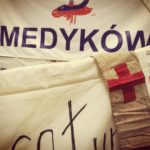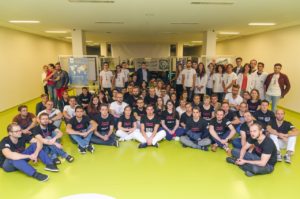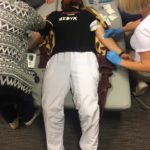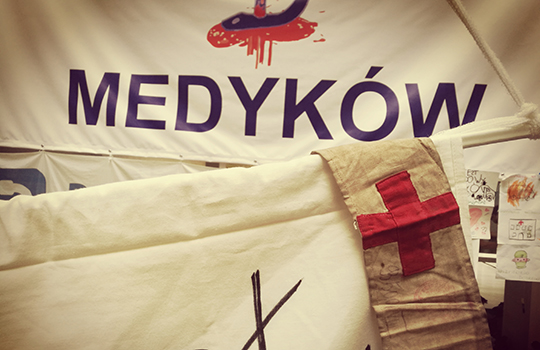 For the past twenty years the public healthcare system in Poland has been struggling with extremely low financing. In 2005, countries such as France and Germany were spending 11.1% and 10.7% GDP on healthcare respectively. According to the OECD, currently in Poland we only spend 6.4% GDP on our healthcare system. [1] This is one of the lowest rates of spending among all OECD countries.
For the past twenty years the public healthcare system in Poland has been struggling with extremely low financing. In 2005, countries such as France and Germany were spending 11.1% and 10.7% GDP on healthcare respectively. According to the OECD, currently in Poland we only spend 6.4% GDP on our healthcare system. [1] This is one of the lowest rates of spending among all OECD countries.
Such low expenditure on healthcare results in low wages for healthcare staff, excessively long working hours, and poor quality training for medical staff. It also results in poor treatment outcomes and long waiting lists for patients.
Furthermore there is a huge staffing crisis. Poland has one of the lowest numbers of doctors and nurses per capita within all OECD countries—2.3 and 5.2 per 1000 population accordingly, and very low wages—the average salary of a junior doctor excluding taxes is 14.87 PLN per hour (3.12 GBP). [1] After a series of protests by healthcare staff, the new Minister of Health Regulation has said that it will increase slightly to 19.87 PLN (4.17 GBP) per hour [3]. This negligence from the government has prompted the medical society “Porozumienie Rezydentów” to protest. For two past years doctors and other medical workers have taken part in two demonstrations. Tens of thousands of people participated in each strike and a petition was signed calling for public spending on healthcare to increase up to 6.8% GDP by 2021. This was supported by over 240 000 signatures [4-5].
 Unfortunately all of these signals were neglected by the Ministry of Health. This is why we had to move towards more drastic action. In October, a hunger strike began at the Pediatric Hospital of the Medical University of Warsaw. After a dozen days, seven other cities joined the protest. The whole hunger strike lasted 29 days, involving more than 200 health workers, mainly young doctors. During this time tens of spontaneous, non-political demonstrations gathered thousands of people in every big city in Poland.
Unfortunately all of these signals were neglected by the Ministry of Health. This is why we had to move towards more drastic action. In October, a hunger strike began at the Pediatric Hospital of the Medical University of Warsaw. After a dozen days, seven other cities joined the protest. The whole hunger strike lasted 29 days, involving more than 200 health workers, mainly young doctors. During this time tens of spontaneous, non-political demonstrations gathered thousands of people in every big city in Poland.
At the end of a day we are all patients. The first aim of the protest was to increase public expenditure on healthcare to 6.8% of GDP within three years. We also called for an improvement in working conditions and wages for all medical workers. This protest attracted enormous media and public attention. Sixty-three percent of Poles supported the aims of the protest, according to an independent, nationwide study by IBRIS [6]. Representatives of the doctors on protest spent long hours in meetings with the Parliamentary Healthcare Committee and with the Prime Minister’s emissaries. Despite support offered, among others, by the Conference of Rectors of Medical Universities, the Supreme Medical Council and the unions, and mediation conducted at the Medical University of Warsaw, no agreement has been reached. The hunger strikes have spread into hospitals across the country. [7-8].
 Despite support from citizens, national, and international medical organizations the government has not agreed to any of settlements proposed by the doctors. Once again numerous policy statements to the Ministry of Health, the Ministry of Finance and to the prime minister have been issued, but nothing has changed. Due to the lack of agreement, the Polish Chamber of Physicians and Dentists and the Polish Medical Doctors Union have decided to escalate the protest [10]. Currently because doctors earn such low wages, more than 89% of doctors in Poland need to work extra hours to support their families [14]. The whole healthcare system is based on doctors working up to 400 hours per month.
Despite support from citizens, national, and international medical organizations the government has not agreed to any of settlements proposed by the doctors. Once again numerous policy statements to the Ministry of Health, the Ministry of Finance and to the prime minister have been issued, but nothing has changed. Due to the lack of agreement, the Polish Chamber of Physicians and Dentists and the Polish Medical Doctors Union have decided to escalate the protest [10]. Currently because doctors earn such low wages, more than 89% of doctors in Poland need to work extra hours to support their families [14]. The whole healthcare system is based on doctors working up to 400 hours per month.
 Therefore, starting from 1 January 2018, Polish physicians will limit their workload to 48 hours per week, according to the EU Working Time Directive (2003/88/EC) and Polish Labour Law [15]. Time will show whether this will result in any substantial change in financing the health care system.
Therefore, starting from 1 January 2018, Polish physicians will limit their workload to 48 hours per week, according to the EU Working Time Directive (2003/88/EC) and Polish Labour Law [15]. Time will show whether this will result in any substantial change in financing the health care system.
Dr David Wrigley, a GP in Lancashire and chair of Doctors in Unite has said “I have been in regular contact with Dr Dabrowski during this action and I was shocked to learn that doctors in a European country had been pushed so far to the limit that they felt they had to go on hunger strike to try and improve their terms and conditions. We send all our best wishes to them and support them 100%. We understand what it is like to work under a government that doesn’t listen to its workforce and continues on a path of destruction of their own health service.”
Photos:
1. Hand band offered as a token of support by Ms. Anna Przedpełska-Trzeciakowska, veteran of The II World War and military nurse during Warsaw Uprising in 1944.
2. Evening photo from 20th day of the protest. Residents, physical therapists, laboratory diagnosticians on hunger protest wearing black. Those who are already disqualified in white. At the highest moment 40 people were on hunger strike in Warsaw.
3. One of many press conferences held in Pediatric Hospital, Warsaw during the protest. Supporters and media filled the whole lobby.
4. One of doctors receiving medical treatment.
Filip A. Dabrowski, Junior Doctors Committee, Supreme Medical Council, Polish Chamber of Physicians and Dentists, and 1st Department of Obstetrics and Gynecology, Medical University of Warsaw.
Jaroslaw Bilinski, Resident Union, Polish Medical Doctors Union, Bydgoszcz, and Department of Hematology, Oncology and Internal Diseases, Medical University of Warsaw, Poland
Natalia Bilinska, Department of Pediatric Gastroenterology and Nutrition, Medical University of Warsaw, Poland
Lukasz Jankowski, Resident Union, Polish Medical Doctors Union, Bydgoszcz and Department of Transplantation Medicine, Nephrology, and Internal Medicine, Institute of Transplantology, Medical University, Warsaw, Poland
Mikolaj Sinica, Resident Union, Polish Medical Doctors Union, Bydgoszcz, Poland
Michal Bulsa, Resident Union, Polish Medical Doctors Union, Bydgoszcz, department of Gynecological Surgery and Gynecological Oncology of Adults and Adolescents, Pomeranian Medical University in Szczecin, Poland.
References:
- OECD. Health at a Glance 2017: OECD Indicators. OECD Publishing, Paris. Published 10.11.2017, available at: http://dx.doi.org/10.1787/health_glance-2017-en
- BAROMETR WHC Raport na temat zmian w dostępności do gwarantowanych świadczeń zdrowotnych w Polsce nr 17/2/08/2017. Stan na czerwiec/lipiec 2017 r. Watch Health Care Foundation. Polish for Barometer WHC- Report of Changes in Access to Guaranteed Services. Situational Analysis for June/July 2017 available at: http://www.korektorzdrowia.pl/wp-content/uploads/barometrwhc_xvii_2017_fin.pdf
- Rozporządzenie Ministra Zdrowia z dnia 27 października 2017 r. w sprawie wysokości zasadniczego wynagrodzenia miesięcznego lekarzy i lekarzy dentystów odbywających specjalizacje w ramach rezydentury. Published 30.10.2017, available at: http://dziennikustaw.gov.pl/du/2017/2017/1
- Bettany K. Junior doctors rise up in Poland. BMJ 2016; 353 :i3472 doi: 10.1136/bmj.i3472
- Dabrowski FA, Oleksiak A, Sladowska A. Problems of junior doctors in Poland: scientific insight BMJ 2016; 354 :i4132 doi: 10.1136/bmj.i4132
- Dąbrowska Z. Rezydenci mają rację w sporze z rządem. Published 24.10.2017, available at: http://www.rp.pl/Spoleczenstwo/171029455-Sondaz-Rezydenci-maja-racje-w-sporze-z-rzadem.html
- Ministry of Health. Wzrost nakładów na ochronę zdrowia do 6 proc. PKB Published 19.10.2017, available at: http://www.mz.gov.pl/aktualnosci/wzrost-nakladow-na-ochrone-zdrowia-do-6-proc-pkb/
- Ustawa o sposobie ustalania najniższego wynagrodzenia zasadniczego pracowników wykonujących zawody medyczne zatrudnionych w podmiotach leczniczych. Published 01.08.2017, available at: http://dziennikustaw.gov.pl/du/2017/1473/1
- International support letters are available on the web page of Polish Medical Chamber: http://www.nil.org.pl/dla-lekarzy/protest/poparcie-zagranicznych-organizacji-lekarskich?result_2987_result_page=1
- The Polish Chamber of Physicians and Dentists. APEL Nr 9/17/IIV Naczelnej Rady Lekarskiej z dnia 27 października 2017 r. do lekarzy. Published 27.10.2017, available at: http://www.nil.org.pl/aktualnosci/opt-out-apel-do-lekarzy
- Study by Silesian Medical Chamber from 2016, where 3000 contracts in 73 hospitals were analysed, results available at: http://www.rynekzdrowia.pl/Finanse-i-zarzadzanie/Slaska-Izba-Lekarska-o-zarobkach-lekarzy,162780,1.html
- Poland- Health System Review. WHO. Health Systems in Transitions. Vol 13. No.8 2011available at: http://www.euro.who.int/__data/assets/pdf_file/0018/163053/e96443.pdf
- Incomes and living conditions of the population in Poland (report from the EU-SILC survey of 2015). Dochody I Warunki Zycia Ludnosci Polski. 06.04.2017. Glowny Urzad Statystyczny (GUS) available at: http://stat.gov.pl/en/topics/living-conditions/living-conditions/incomes-and-living-conditions-of-the-population-in-poland-report-from-the-eu-silc-survey-of-2015,1,9.html
- Nationwide survey among 2691 doctors and dentists under 35 years of age on the current specialist training system in Poland available at: http://www.nil.org.pl/__data/assets/pdf_file/0019/107344/Raport_Ksztalcenie_podyplomowe_cz_1_Podsumowanie_najwazniejszych_wynikow…..pdf
- European Parliament and Council. Directive 2003/88/EC Published 4.11.2017 available at:http://eur-lex.europa.eu/legal-content/EN/TXT/?uri=CELEX:32003L0088
- Green Book of Polish Health Care, Warsaw 2008 available at: http://www.sluzbazdrowia.com.pl/pdf/ZielonaKsiegaII.pdf
- Ministry of Health Annual Report available at: http://www2.mz.gov.pl/wwwfiles/ma_struktura/docs/raport_zk_211204.pdf
- Health Care in Poland, annual report of Central Statistical Office of Poland, available at: http://stat.gov.pl/obszary-tematyczne/zdrowie/zdrowie/
